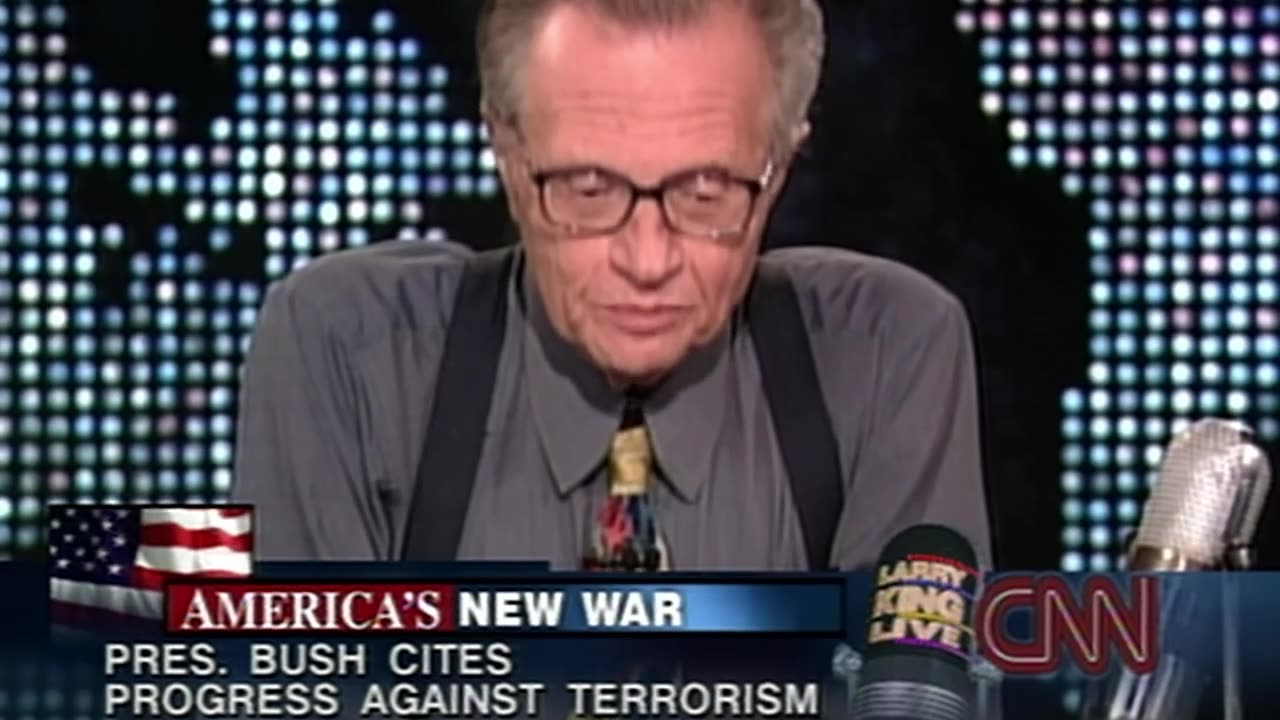Premium Only Content

Fahrenheit 9/11 (2004) Full Documentary
Fahrenheit 9/11 is a 2004 American documentary film directed, written by, and starring filmmaker, director, political commentator and activist Michael Moore.[2] The subjects of the film are the presidency of George W. Bush, the Iraq War, and the media's coverage of the war. In the film, Moore claims that American corporate media were cheerleaders for the 2003 invasion of Iraq, and did not provide an accurate or objective analysis of the rationale for the war and the resulting casualties there.
The title of the film alludes to Ray Bradbury's 1953 novel Fahrenheit 451, a dystopian view of the future United States, drawing an analogy between the autoignition temperature of paper and the date of the September 11 attacks; one of the film's taglines was "The Temperature at Which Freedom Burns".
The film debuted at the 2004 Cannes Film Festival, where it was awarded the Palme d'Or,[3] the festival's highest award. It received generally positive reviews from critics, but it also generated intense controversy, particularly including disputes over its accuracy. The film became the highest-grossing documentary of all time (later surpassed by Michael Jackson's This Is It), grossing over $220 million. A follow-up, titled Fahrenheit 11/9, about the presidency of Donald Trump, was released in September 2018.
Synopsis
The documentary begins by suggesting that friends and political allies of George W. Bush at Fox News Channel tilted the election of 2000 by prematurely declaring Bush the winner. It then suggests that the handling of the voting controversy in Florida constituted election fraud.
The documentary then segues into the September 11 attacks of 2001. Moore says Bush was informed of the first plane hitting the World Trade Center on his way to an elementary school in Florida. Bush is then shown sitting in an Emma E. Booker Elementary School classroom with children. When told that a second plane has crashed into the World Trade Center and that the nation is "under attack", Bush allows the students to finish their book reading, and Moore notes that he continued reading The Pet Goat for nearly seven minutes.
Moore then discusses the complex relationships between the U.S. government and the Bush family; and between the bin Laden family, the Saudi Arabian government, and the Taliban, which span over three decades. Moore then states that the United States government evacuated 24 members of the bin Laden family on a secret flight shortly after the attacks, without subjecting them to any form of interrogation.
Moore moves on to examine George W. Bush's Texas Air National Guard service record. Moore contends that Bush's dry-hole oil well attempts were partially funded by the Saudis and by the bin Laden family through the intermediary of James R. Bath, whose name is shown to have been blacked out from Bush's records. Moore alleges that these conflicts of interest suggest that the Bush administration does not serve the interests of Americans. The movie continues by suggesting ulterior motives for the War in Afghanistan, including a natural gas pipeline through Afghanistan to the Indian Ocean.
Moore alleges that the Bush administration induced a climate of fear among the American population through the mass media. Moore then describes purported anti-terror efforts, including government infiltration of pacifist groups and other events, and the signing of the USA PATRIOT Act.
The documentary then turns to the subject of the Iraq War, comparing the lives of the Iraqis before and after the invasion. The citizens of Iraq are portrayed as living relatively happy lives prior to the country's invasion by the U.S. Armed Forces. The film also takes pains to demonstrate war cheerleading in the U.S. media and general bias of journalists, with quotes from news organizations and embedded journalists. Moore suggests that atrocities will occur in Iraq and shows footage depicting U.S. abuse of prisoners.
Later in the film, Lila Lipscomb appears with her family after hearing of the death of her son, Sgt. Michael Pedersen, who was killed on April 2, 2003, in Karbala. Anguished and tearful, she begins to question the purpose of the war.
Tying together several themes and points, Moore compliments those serving in the U.S. military. He claims that the working class of America are always the first to join the Army, so that the people better off do not have to join. He states that those valuable troops should not be sent to risk their lives unless it is necessary to defend America. The credits roll while Neil Young's "Rockin' in the Free World" plays. (Moore had originally intended to use the Who's "Won't Get Fooled Again" but was denied permission by Pete Townshend).[4]
Moore dedicated the film to his friend who was killed in the World Trade Center attacks and to those servicemen and women from Flint, Michigan that have been killed in Iraq: "Michael Pedersen, Brett Petriken and all the soldiers from the Flint area who have died in the Iraq War ... Bill Weems and the 2973 who died on 9/11/01 ... and the countless thousands who have died in Afghanistan and Iraq as a result of our actions."
Production
Originally planned to be financed by Mel Gibson's Icon Productions (which planned to give Michael Moore eight figures in upfront cash and potential backend),[5] Fahrenheit 9/11 was later picked up by Miramax Films and Wild Bunch in May 2003 after Icon Productions had abruptly dropped the financing deal it made.[6] Miramax had earlier distributed another film for Moore, The Big One, in 1997.
At that time, Disney was the parent company of Miramax. According to the book DisneyWar, Disney executives did not know that Miramax agreed to finance the film until they saw a posting on the Drudge Report. Michael Eisner (the CEO of Disney at that time) called Harvey Weinstein (co-chairman of Miramax at that time) and ordered him to drop the film. In addition, Disney sent two letters to Weinstein demanding Miramax drop the film. Weinstein felt Disney had no right to block the releasing of Fahrenheit 9/11 since the film's $6 million budget was well below the level at which Miramax needed to seek Disney's approval, and it would not be rated NC-17.[7] But Weinstein was in contract negotiations with Disney, so he offered a compromise that he would drop the film if Disney did not like it.[7] Disney responded by having Peter Murphy send Weinstein a letter stating that the film's $6 million budget was only a bridge financing and Miramax would sell off its interest in the movie to get those $6 million back; according to the same letter, Miramax was also expected to publicly state that it would not release the film.[7]
After Fahrenheit 9/11 was nearly finished, Miramax held several preview screenings; they were "testing through the roof".[8] Weinstein informed Eisner that Fahrenheit 9/11 was finished, and Eisner was surprised by the fact that Miramax had continued making the film.[8] Weinstein asked several Disney executives (including Eisner) to watch the film, but all declined; Disney stated again that Miramax would not release the film, and Disney also accused Weinstein of hiding Fahrenheit 9/11 by keeping it off production reports.[8] Disney sent production vice President Brad Epstein to watch Fahrenheit 9/11 on April 24, 2004.[8] According to Weinstein, Epstein said he liked the film; but according to the report Epstein sent to the Walt Disney Company board of directors, Epstein clearly criticized it.[8] Eisner told Weinstein that Disney's board decided not to allow Miramax to release the film.[8] Weinstein was furious and he asked George J. Mitchell (chairman of Disney at that time) to see the film, but Mitchell declined.[8] Weinstein asked lawyer David Boies to help find a solution;[8] the Weinsteins and Moore had also hired Chris Lehane to consult on the film's release strategies.[9] Lehane suggested to reveal Disney's decision to The New York Times.[10]
The New York Times reported about Disney's decision on May 5, 2004.[11] Disney stated that both Moore's agent (Ari Emanuel) and Miramax were advised in May 2003 that Miramax would not be permitted to distribute the film. Disney representatives said Disney had the right to veto any Miramax film if it appeared that its distribution would be counterproductive to the interests of the company; indeed, Disney had blocked Miramax from releasing two films before: Kids and Dogma.[12]
Because of these difficulties, distribution was first secured in numerous countries outside the U.S. On May 28, 2004, after more than a week of talks, Disney announced that Miramax film studio founders Harvey and Bob Weinstein had personally acquired the rights to the documentary after Disney declined to distribute it. The Weinsteins agreed to repay Disney for all costs to that point, estimated at around $6 million. They also agreed to be responsible for all costs to finish the film and all marketing costs not paid by any third-party film distributors.[13] A settlement between the Weinsteins and Disney was also reached so that 60% of the film's profit would be donated to charity.[14]
The Weinsteins established Fellowship Adventure Group to handle the distribution of this film. Fellowship Adventure Group joined forces with Lions Gate Entertainment (which had released two other Miramax-financed films O and Dogma)[15] and IFC Films to release it in the United States theatrically. (Fellowship Adventure Group also handled the film's U.S. home video distribution through Columbia TriStar Home Entertainment). Moore stated that he was "grateful to them now that everyone who wants to see it will now have the chance to do so.[16]
After being informed that the film had been given an R rating by the Motion Picture Association of America, Moore appealed the decision, hoping to obtain a PG-13 rating instead. Moore's lawyer, former Governor of New York, Mario Cuomo, was not allowed to attend the hearing. The appeal was denied on June 22, 2004, and Cuomo contended that it was because he had been banned from the hearing. Some theaters chose to defy the MPAA and allow unchaperoned teenagers to attend screenings.[17]
Release
Alternate Fahrenheit 9/11 poster
The film was released theatrically by The Fellowship Adventure Group through a distribution arrangement with Lions Gate Entertainment. On its opening weekend of June 25–27, 2004, the film generated box-office revenues of $23.9 million in the United States and Canada, making it the weekend's top-grossing film. Its opening weekend earned more than the entire U.S. theatrical run of any other feature-length documentary (including Moore's previous film, Bowling for Columbine). The film was released in the United Kingdom on July 2, 2004 and in France on July 7, 2004.[18]
Moore credited part of the theatrical success to the efforts of conservative groups to pressure theaters not to run the film, conjecturing that these efforts backfired by creating publicity. There were also efforts by liberal groups such as MoveOn.org (who helped promote the film) to encourage attendance in order to defy their political opponents' contrary efforts.[19]
Fahrenheit 9/11 was screened in a number of Middle Eastern countries, including the United Arab Emirates, Lebanon, and Egypt, but was immediately banned in Kuwait. "We have a law that prohibits insulting friendly nations", said Abdul-Aziz Bou Dastour of the Kuwaiti Information Ministry.[20][21] The film was not shown in Saudi Arabia as public movie theaters were not permitted from 1983 until 2017. The Saudi ruling elite subsequently launched an advertising campaign spanning nineteen US cities to counter criticism partly raised in the film.[22] Democratic members of the Coalition Provisional Authority in U.S.-occupied Iraq had the film screened at the Republican Palace in Baghdad.[23]
In Cuba, bootlegged versions of the film were shown in 120 theaters, followed by a prime-time television broadcast by the leading state-run network. It had been widely reported that this might affect its Oscar eligibility, since the film was broadcast on television less than nine months after its theatrical release. However, soon after that story had been published, the Academy of Motion Picture Arts and Sciences issued a statement denying this, saying, "If it was pirated or stolen or unauthorized we would not blame the producer or distributor for that".[24] In addition, Wild Bunch, the film's overseas distributor for Cuba, issued a statement denying a television deal had been struck with Cuban Television. The issue became moot, however, when Moore decided to forgo Oscar eligibility in favor of a pay-per-view televising of the film on November 1, 2004.
Critical reception
The film was received positively by critics. Review aggregator website Rotten Tomatoes reports an approval rating of 82% based on 237 reviews, with an average rating of 7.33/10. The site's critics' consensus reads: "Extremely one-sided in its indictment of the Bush administration, but worth watching for the humor and the debates it'll stir."[25] It also received a score of 67 (generally favorable) on Metacritic, based on 43 reviews.[26]
Film critic Roger Ebert, who gave the documentary three and a half stars out of four, said that the film "is less an exposé of George W. Bush than a dramatization of what Moore sees as a failed and dangerous presidency", and added: "Moore brings a fresh impact to familiar material by the way he marshals his images".[27]
Joe Morgenstern of The Wall Street Journal described the film as "rambling, troubling and sometimes rousing", and wrote: "At its best, "Fahrenheit 9/11" is an impressionist burlesque of contemporary American politics that culminates in a somber lament for lives lost in Iraq. But the good stuff—and there's some extremely good stuff—keeps getting tainted by Mr. Moore's poison-camera penchant for drawing dark inferences from dubious evidence."[28]
Entertainment Weekly put it on its end-of-the-decade, "best-of" list, saying, "Michael Moore's anti-Bush polemic gave millions of frustrated liberals exactly what they needed to hear in 2004—and infuriated just about everyone else. Along the way, it became the highest-grossing documentary of all time."[29]
Commercial performance
Grossing over $222 million total worldwide, the film is the highest grossing documentary of all time, according to Box Office Mojo.[1] The film had a general release in the United States and Canada on June 23, 2004. It has since been released in 42 more countries. On Al-Jazeera in August 2012, Moore claimed the movie "grossed about half a billion dollars" worldwide.[30] It was the highest-grossing film released by Lionsgate until it was surpassed by The Hunger Games in 2012.[31]
Home media
Fahrenheit 9/11 was released to DVD and VHS on October 5, 2004, an unusually short turnaround time after theatrical release. In the first days of the release, the film broke records for the highest-selling documentary ever. About two million copies were sold on the first day, most of which (1.4 million) were sold as rentals.[32]
A companion book, The Official Fahrenheit 9/11 Reader, was released at the same time. It contains the complete screenplay, documentation of Moore's sources, audience e-mails about the film, film reviews, and articles.
Initial television presentations
This section does not cite any sources. Please help improve this section by adding citations to reliable sources. Unsourced material may be challenged and removed. (September 2012) (Learn how and when to remove this template message)
The two-hour film was planned to be shown as part of the three-hour "The Michael Moore Pre-Election Special" on iN DEMAND, but iN DEMAND backed out in mid-October. Moore later arranged for simultaneous broadcasts on November 1, 2004 at 8:00 p.m. (EST) on Dish Network, TVN, and the Cinema Now website and material prepared for "The Michael Moore Pre-Election Special" was incorporated into "Fahrenheit 9/11: A Movement in Time", which aired that same week on The Independent Film Channel.
The movie was also shown on basic cable television in Germany and Austria on November 1, 2004 and November 2, 2004. In the UK, the film was shown on Channel 4 on January 27, 2005. In Hungary, it was shown on RTL Klub, a commercial channel, on September 10, 2005, on m1, one of the national channels, on August 13, 2006, on m2, the other national channel, on September 1, 2006. In Denmark, it was shown on Danmarks Radio (normally referred to as just DR), which is Denmark's national broadcasting corporation, on April 11, 2006. In Norway, it was shown on NRK, the national broadcasting corporation, on August 27, 2006. The film was screened in New Zealand on September 9, 2006 on TV ONE, a channel of TVNZ. The next day, the Dutch network Nederland 3 aired the film. In Belgium, it was shown on Kanaal 2 on October 12, 2006. In Brazil, it aired on October 10, 2008 on TV Cultura, the São Paulo public broadcasting network.
https://en.wikipedia.org/wiki/Fahrenheit_9/11
https://tubitv.com/movies/579647?utm_source=justwatch-feed&tracking=justwatch-feed
-
 1:17:27
1:17:27
Man in America
16 hours agoEvidence of Highly Advanced Ancient Civilizations Is Being Hidden — But WHY!? w/ Jay Anderson
132K40 -
 8:00:05
8:00:05
SpartakusLIVE
15 hours agoDuos w/ GloryJean || Friday Night HYPE w/ The MACHINE
66.1K1 -
 3:47:23
3:47:23
Nerdrotic
17 hours ago $36.95 earnedFantastic 4 HER! Daredevil BORE Again SUCKS! Disney Star Wars is DESPERATE | FNT Vegas 350
168K30 -
 5:21:14
5:21:14
MyronGainesX
1 day ago $29.54 earnedFormer Fed Explains FSU Shooter, RFK Files Released, And Charlie Kirk Debates Anti-Israel Vet!
132K44 -
 1:03:22
1:03:22
IsaacButterfield
15 hours ago $5.44 earnedKaty Perry in Space?! Trans Women Law Controversy & Lizzo's Weight Loss Shocks Fans!
64.8K20 -
 6:15:39
6:15:39
Sm0k3m
12 hours agogaming night
63.3K1 -
 3:48:35
3:48:35
I_Came_With_Fire_Podcast
20 hours agoHOUTHIS & CHINA | MURDERER MERCH STORE | TRUMP SICK OF WAITING
62.8K14 -
 1:09:15
1:09:15
Keepslidin
10 hours ago $1.49 earnedIRL GAMBLING & GIVING PEOPLE MONEY WHEN THEY WIN
36K5 -
 6:10:30
6:10:30
Eternal_Spartan
21 hours agoLive at 9pm Central | Halo 3 & Halo Firefight! Come Hang out with a USMC Vet and join the best chat!
35K1 -
 4:06:20
4:06:20
VapinGamers
12 hours ago $2.10 earnedFortnite Friday - Game Night with the Family - !brian !rumbot
38K6